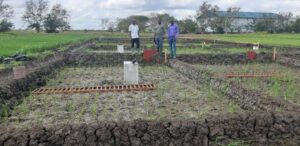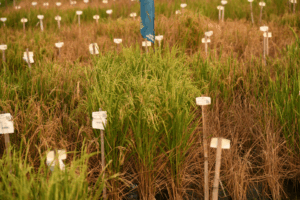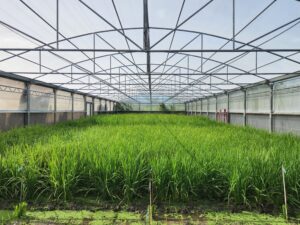Vegetable farming is an important sub-sector to increase income, reduce poverty, and improve nutrition, particularly in the developing countries. Although Nepal’s vegetable farming is dominated by smallholders, it is gradually changing from subsistence to commercial type. Improving productivity and profitability in agriculture is central to make this sector economically sustainable. This requires understanding of technical, allocative and economic efficiencies, and factors determining them.
Vegetable farming is an important sub-sector to increase income, reduce poverty, and improve nutrition, particularly in the developing countries. This sector provides greater opportunities for self-employment to different actors of the food value chain such as input suppliers, farmers, traders, transporters, processors, and other supportive line agencies. Nepalese economy has long been relying on agriculture, which shares more than 25% of the gross domestic product (GDP) where vegetable is one of the major components in contributing to the Agriculture Gross Domestic Product (AGDP).
The Ministry of Agriculture and Livestock Development (MOALD) reported that in 2019, more than 3.2 million farmers were involved in vegetable farming and produced 3.96 million tons of vegetables under 0.69 million acres of land with average yield of 5.74 tons/acre. Despite the huge contribution to the AGDP, the growth rate of this sector has decreased from 5.98% (2007–2009) to 3.07% (2010–2019), and the productivity remains low, which is lowest in Asian countries. Thus, enhancing productivity is crucial to narrow down the productivity gap (productivity potential 7 tons/acre) and eventually improve the technical, allocative, and economic efficiencies in vegetable production.
The major agricultural policies of Nepal, as it does not have a separate vegetable policy, are Agriculture Perspective Plan (APP), Agriculture Development Strategy (ADS), and Fourteenth Development Plan 2019–2024.
The main objectives of these policies are to alleviate poverty and ensure food and nutrition security through transforming subsistence agriculture into commercial and competitive agriculture. In spite of these greater efforts, the agriculture sector has not been successful in improving income, livelihoods, food security, and nutrition, particularly of the vulnerable groups such as the landless, smallholders, women, and children. In order to address these issues and improve the agriculture sector, appropriate empirically tested evidence-based policies and programs need to be formulated.
Nepalese vegetable farms are characterized by <1 ha farm size with the average agricultural landholding of 0.7 hectare (ha) and integrated cropping systems where different vegetable crops are grown in a single farm. Most farmers grow vegetables in their own land, adopt both improved and local varieties, use manual and animal power in plowing their land, and use different fertilizers and chemicals including compost, green manure, chemical fertilizers, and pesticides.
The common constraints encountered by smallholder vegetable farmers are subsistence-oriented farming, lack of improved technologies, inadequate extension services, poor road networks and infrastructure, and poor market facilities that led agriculture sector less productive and inefficient.
Although Nepal’s vegetable farming is dominated by smallholders, it is gradually changing from subsistence to commercial type. Improving productivity and profitability in agriculture is central to make this sector economically sustainable. This requires understanding of technical, allocative and economic efficiencies, and factors determining them.
Past research studies on vegetable farming in Nepal were mainly focused on cost-benefit analysis, value chain analysis, and marketing issues. To our knowledge, literature analyzing the profit efficiency of smallholder vegetable farmers of Nepal is limited. This study aims to bridge this knowledge gap. The paper examines two main research questions.
First, what is the level of profit efficiency in vegetable farming in Nepal?
Second, what factors determine the profit efficiency in vegetable farming in Nepal? The main objective of this study is to measure the profit efficiency, determine factors affecting inefficiency, and derive policies to increase profitability and income of smallholder vegetable farms.
The paper will contribute to the body of knowledge on methodology for agriculture production efficiency analysis, understanding efficiency in vegetable farming, and identifying factors contributing to inefficiency in vegetable farming in Nepal. The relationship of the profit efficiency with different variables such as production inputs, socioeconomic factors, and technology would be useful in formulating policies and programs to improve input use efficiency, address socio-economic constraints, and to make the vegetable sector economically more competitive and efficient.
As the study areas and sample units were considered from diverse agro-ecological settings, the finding can be inferred to the whole country and to similar agro-ecologies in other countries.
Enhancing productivity, profitability and the profit efficiency in vegetable farming improve income, livelihood, and nutrition of smallholder farmers. This study measured the profit efficiency of smallholder vegetable farms and identified factors affecting profit inefficiency using the stochastic frontier function. The mean of the profit efficiency was found to be 0.72, which indicated that 28% inefficiency could be removed by implementing appropriate managerial, technological, institutional, and policy interventions.
The input variables, labor, seed, fertilizer, pesticide, land, and capital, were proved to be significant factors to determine profit in vegetable farming. The policymakers should focus on policy formulation to educate farmers in allocating resources at the optimum proportion to achieve the frontier level of profit. The socio-economic variables, improved seed varieties, better information, higher number of contacts with extension workers, long years of experience in vegetable farming, farms near to the markets, and female farmers, demonstrated better performance in profit efficiency.
Therefore, policy interventions should be tailored to promote improved seed varieties in vegetable farming, provide effective information services to the farmers, deliver effective extension services, provide financial access to the farmers, develop markets linking with production areas, and encourage women in vegetable farming with adequate incentive packages to enhance profit efficiency.
Read the study:
Shrestha RB, Bhandari H, and Pandey S. (2022) Profit Efficiency of Smallholder Vegetable Farms in Nepal: Implications for Improving Household Income. Frontiers in Sustainable Food Systems Vol. 5






